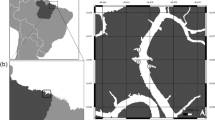Summary
An extremely elaborate performance, involving endogenous timing with both tidal and lunar frequencies, has been recorded in the locomotor activity of an adult specimen of the intertidal isopod,Excirolana chiltoni. During two months of observation, under constant, non-tidal conditions, this animal showed a persistent tidal rhythm in its swimming activity. Bursts of activity were initially well synchronized with times of tide crest on the shore. The average free-running period of the tidal rhythm was about 24 h 55 min, i.e. about 5 minutes longer than the average period of the tides; thus, the loss of synchrony with the concurrent tides was very gradual. The amount of activity per burst showed a conspicuous pattern of variation, a periodic amplitude modulation which paralleled, in detail, the complex lunar cycle of changes in height of high tide. The free-running period of the bimodal, circa-lunar rhythm of amplitude modulation was one or two days longer than the natural 29-day lunar cycle of tide heights.
Each feature of this recording has been qualitatively replicated in activity records from other individuals of this species. Freshly-collectedExcirolana generally show spontaneous bursts of activity at times of tide crest, bursts which are repeated as a persistent tidal rhythm, the period of which commonly departs by only a few minutes from that of the natural tidal cycle. Superimposed on the tidal rhythm is an endogenous monthly pattern of amplitude modulation, which alters the amount of activity per burst. This circa-lunar rhythm has a free-running period between about 26 and 33 days, and generally leads to maximum activity on days of highest of high tides. The net result of the tidal and lunar rhythms is an activity pattern which permits the isopods to recapitulate, in great detail, certain significant ecological aspects of the mixed, semi-diurnal tidal regime of California.
The experimental data are not compatible with the hypothesis that uncontrolled environmental factors, such as vibrations from waves, were responsible for the rhythmic behavior of the animals. Neither do the data support the hypothesis that “beats” between the observed tidal rhythm and a hidden daily or circadian rhythm were responsible for the observed circa-lunar rhythm. Furthermore, the pattern of the circa-lunar rhythm cannot be accounted for by a single monthly oscillation in the “excitability” of the animals, such as might be mediated by changes in the level of an excitatory or inhibitory hormone in the circulatory system.
Similar content being viewed by others
References
Aschoff, J.: Orcadian activity pattern with two peaks. Ecology47, 657–662 (1966).
Barnwell, F. H.: Daily and tidal patterns of activity in individual fiddler crabs (genusUca) from the Woods Hole region. Biol. Bull.130, 1–17 (1966).
Barnwell, F. H.: The role of rhythmic systems in the adaptation of fiddler crabs to the intertidal zone. Amer. Zool.8, 569–583 (1968).
Bennett, M. F., Shriner, J., Brown, R. A.: Persistent tidal cycles of spontaneous motor activity in the fiddler crab,Uca pugnax. Biol. Bull.112, 267–275 (1957).
Bohn, G.: Sur les mouvements oscillatoires desConvoluta roscoffensis. C. R. Acad. Sci. (Paris)137, 576–578 (1903).
Bünning, E., Müller, D.: Wie messen Organismen lunare Zyklen? Z. Naturforsch.16 b, 391–395 (1961).
Chandrashekaran, M. K.: Persistent tidal and diurnal rhythms of locomotor activity and oxygen consumption inEmerita asiatica (M.-Edw.). Z. vergl. Physiol.50, 137–150 (1965).
Enright, J. T.: The tidal rhythm of activity of a sand-beach amphipod. Z. vergl. Physiol.46, 276–313 (1963).
Enright, J. T.: The search for rhythmicity in biological time series. J. theor. Biol.8, 426–468 (1965a).
Enright, J. T.: Entrainment of a tidal rhythm. Science147, 864–867 (1965b).
Enright, J. T.: Heavy water slows biological timing processes. Z. vergl. Physiol.72, 1–16 (1971a).
Enright, J. T.: The internal clock of drunken isopods. Z. vergl. Physiol.75, 332–346 (1971b).
Gibson, R. N.: Factors affecting the rhythmic activity ofBlennius pholis L. (Tele-ostei). Anim. Behav.19, 336–343 (1971).
Hamner, W. M., Enright, J. T.: Relationships between photoperiodism and circadian rhythms of activity in the house finch. J. exp. Biol.46, 43–61 (1967).
Hauenschild, C.: Lunar periodicity. Cold Spr. Harb. Symp. quant. Biol.25, 491–497 (1960).
Heusner, A. A., Enright, J. T.: Long-term activity recording in small aquatic crustaceans. Science154, 532–533 (1966).
Jones, D. A., Naylor, E.: The swimming rhythm of the sand beach isopodEurydice pulchra. J. exp. mar. Biol. Ecol.4, 189–199 (1970).
Klapow, L. A.: The ecology and behavior of a sand-beach isopod,Excirolana chiltoni: distribution, abundance and temporal pattern in molting, reproduction and swimming activity. PhD thesis, Univ. of Calif, at San Diego, 1971.
Morgan, E.: The activity rhythm of the amphipodCorophium volutator (Pallas) and its possible relationship to changes in hydrostatic pressure associated with the tides. J. Anim. Ecol.34, 731–746 (1965).
Naylor, E.: Tidal and diurnal rhythms of locomotor activity inCarcinus maenas (L.). J. exp. Biol.35, 602–610 (1958).
Neumann, D.: Due lunare und die tägliche Schlüpfperiodik der MückeClunio. Z. vergl. Physiol.53, 1–61 (1966).
Neumann, D.: Die Kombination verschiedener endogener Rhythmen bei der zeitlichen Programmierung von Entwicklung und Verhalten. Oecologia (Berl.)3, 166–183 (1969).
Vielhaben, V.: Zur Deutung des semilunaren Fortpflanzungszyklus vonDictyota dichotoma. Z. Bot.51, 156–173 (1963).
Author information
Authors and Affiliations
Rights and permissions
About this article
Cite this article
Enright, J.T. A virtuoso isopod. J. Comp. Physiol. 77, 141–162 (1972). https://doi.org/10.1007/BF00693603
Received:
Issue Date:
DOI: https://doi.org/10.1007/BF00693603




